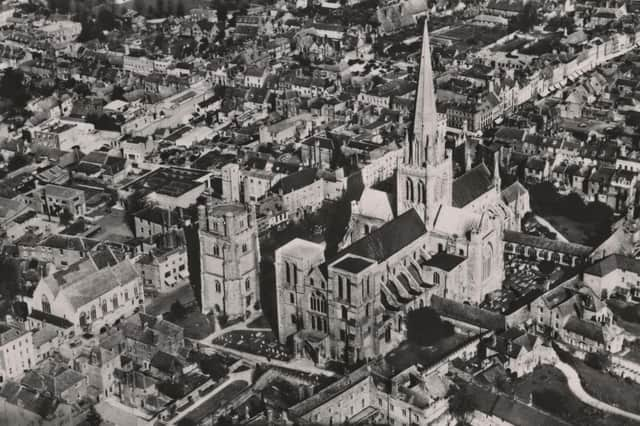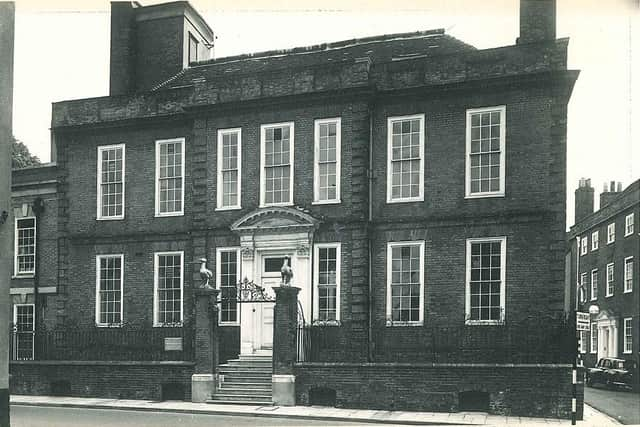How Walter Hussey, Dean of Chichester Cathedral, influenced the Chichester art scene, including the foundation of Pallant House Gallery


His contribution to the cathedral’s renowned art collection was indispensable and his own collection of 20th century paintings and engravings became the basis for Pallant House Gallery, now a leading gallery of British modern art.
Born in Northampton to Canon John Rowden Hussey and his wife Lilian, he followed in his father’s footsteps to become a man of the Church. Educated at The Knoll, a small preparatory school in Woburn Sands, Bedfordshire, he went on to study philosophy, politics and economics at Oxford, graduating in 1930. He subsequently spent some time as a schoolmaster at a preparatory school near Seaford, before training at Cuddesdon Theological College.
Advertisement
Hide AdAdvertisement
Hide AdHussey spent time as curate of the church of St Mary Abbots, Kensington, after which he succeeded his father as vicar of St Matthew’s, Northampton, in 1937. It was during his tenure here that his love of art and music flourished, and his belief fostered that the link between art and religion seen in Medieval churches should be restored. His commissions, both of music and art, saw national and international recognition.


It was here in Northampton that he began a festival of the arts for the Jubilee of the Church in 1943, which included an organ recital from George Thalben-Ball, a concert by the BBC Orchestra, and the commission of both Rejoice in the Lamb by Benjamin Britten and Henry Moore’s sculpture Madonna and Child, unveiled in 1944.
The sculpture celebrated the 50th anniversary of the church and represented Moore’s first religious work and his initial use of drapery in sculpture. The commission of Graham Sutherland’s Crucifixion in 1947 followed shortly after and began Hussey’s vocation of commissioning modern works of art for the church, including music, paintings, poetry and sculpture.
Throughout his incumbency at Northampton, he took on other duties including becoming Master of St John’s Hospice at Weston Favell from 1948 to 1955, and as non-residential Canon of Peterborough Cathedral from 1949 to 1955. He also became Rural Dean of Northampton, before being appointed Dean of Chichester in 1955 by Bishop George Bell, another great patron of the arts.
Advertisement
Hide AdAdvertisement
Hide AdHussey’s approach to art in Chichester was no different than in Northampton and he commissioned several notable works of art, including another by Graham Sutherland, Noli me tangere in 1961, depicting Jesus being recognised after his resurrection; a large tapestry for the High Altar by John Piper, consecrated in 1966, consisting of seven panels standing 5m high and 1m wide depicting the Holy Trinity; works by Geoffrey Clarke, Cecil Collins and Ceri Richards; and his final commission in 1978, a stained-glass window with imagery of instruments mentioned in Psalm 50 by Marc Chagall.


It was through these commissions that Hussey developed personal relationships with many of the artists he worked with, and this is no truer than with the esteemed composer of West Side Story, Leonard Bernstein.
When Hussey wrote to Bernstein in 1963 asking him to compose a new piece of choral music for the Southern Cathedrals Festival in 1965, there was not much hope of a positive response. However, Bernstein quickly responded to accept the invitation and from their correspondence bloomed both a valued friendship and the Chichester Psalms, a composition that was to receive much acclaim and become one of Bernstein’s most-performed pieces.
But it was not just his approach to art in his working life that awarded him national recognition. His private collection, amassed from 1932 until its bequest to Chichester District Council in 1982, which led to the creation of Pallant House Gallery, certified him as a leading collector of British modern art, although his collection was broader than this.
Advertisement
Hide AdAdvertisement
Hide AdHis first acquired work was the costume design for Romeo after seeing the Oxford University Dramatic Society’s production of Romeo and Juliet in 1932 for 10 shillings. From there, his collection grew and became a comprehensive study of different styles and periods, the oldest dating from the beginning of the 16th century. Notable artists such as John Robert Cozens, Thomas Gainsborough, Paul Nash and Eric Ravilious appear throughout but none are more represented than the esteemed Moore, Piper, Richards and Sutherland.
Hussey had been concerned about the neglect Pallant House had been suffering while being used as council offices between 1919 and 1979, after being acquired by Chichester District Council, and so offered to leave his private collection on the condition it would be displayed in a public setting and the house restored. The gallery officially opened in 1982 and offered visitors a marked experience of viewing British masterpieces in a domestic setting.
Hussey had retired from Chichester in 1977, moving to London, and in 1985 published Patron of the Arts – The Revival of a Great Tradition Among Modern Artists. He died on July 25, 1985, and his funeral was held in St Paul’s Church, Knightsbridge.
Hussey’s contribution to Pallant House Gallery and to the city of Chichester was intrinsically important to the evolution of both as leading institutions in the world of art. Pallant House Gallery thrives as a leading modern art museum and the Cathedral continues Hussey’s legacy, with successive Deans commissioning a number of important works, including Ursula Benker-Schirmer’s Tapestry of Atonement in 1985, which hangs beside Piper’s.
The current programme of temporary exhibitions and installations, curated by Jacquiline Creswell, are noted for their inventiveness and ingenuity.